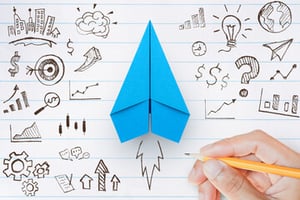Introduction
Thousands of business systems that enterprises currently use for budgeting, approvals, order management among others were built decades ago. There are many pain points that surround these existing applications. Additionally, enterprises tend to have varied infrastructure with some processes using Mainframes, with few other custom-built apps for specific business units.
The usage of legacy applications and the aging infrastructure forces employees to spend around 30% of their time and the companies around 70% of their IT budgets in maintaining these current applications, leaving very little room for innovation. Along with tightly coupled and inflexible architecture, other factors that are driving companies to modernize their applications include, the inability to scale or leverage cloud services and emerging technologies, the heavy technology debt and the incompatibility with the underlying system’s hardware. Non-responsive UI, security vulnerabilities and compliance requirements are also propelling companies to consider converting a legacy system to a newer platform using modern computer programming languages and software libraries.

Marching ahead with Application modernization
When moving towards modernized applications it is critical to decide which of the existing systems need to be retired or modernized. The challenge here lies in identifying, the exact time these systems would reach a point beyond which, maintaining the legacy systems becomes exorbitantly expensive and tedious than working towards modernizing them. The main difference between the 'new development' of an application and the 'application modernization' is that the new development lets the team use the cloud from the beginning of the development cycle, whereas the application modernization is an 'incremental' process which involves, moving your infrastructure and data to the cloud.
The benefits of the modernization of applications are unequivocal. Enterprises get away from the heavy cost of managing a legacy system. Employee productivity rises as the number of application incidents reduce. Customer experience also improves with new features and a more user-friendly interface—all important factors which help in retaining and attracting new customers. Plus, enterprises often gain higher revenues with new services for customers.
However, enterprises need to be aware that the benefits just don’t come automatically. A lot will depend on how they approach the modernization process and manage the risks involved therein, especially in long-term projects. As legacy systems are critical for enterprises, developing and deploying a modernized system all at once is of high operational risk. For business continuity, the modernization of the systems must be done incrementally. Often, this results in both the legacy system as well as the modernized system co-existing together while managing this hybrid infrastructure can be challenging. Hence, during modernization, a proper strategy needs to be followed to ensure that the entire system is fully functional.
Application modernization strategies
Architecture-driven modernization: This strategy is focused on providing standard views of the existing systems such as code analysis, the transformation of the software, etc. that enables modernization. The knowledge discovery metamodel, which is the intermediate representation for existing software systems and their operating environments is the foundation for architecture-driven modernization.
Business-driven approach: Modernization of the applications should focus on value adds to the business by combining the business criticality with its technical quality. Applications can be analyzed for the current and new architectures and based on their contribution to the performance, they can be divided into various categories using applications portfolio analysis (APA).
Model-driven engineering: This is an approach for reverse engineering and then forward engineering of the software to maximize the compatibility between the systems via reusing the standardized domain models. It simplifies the design and improves the communication between the teams working on the system.
Renaissance: The focus here is to allow the teams to iteratively evaluate the legacy systems from the perspective of organizational, business, and technical aspects. This approach defines a process framework, a predefined number of strategies for iterative evolution, an information repository, and a generic set of personal responsibilities.
Warrants, Maintenance, Upgrade (WMU) model: This is a model that lets the teams choose appropriate maintenance strategies based on customer satisfaction and their effects on it.
Follow the 12 Factor Rules
One of the important aspects of application modernization is that it should follow as many rules as possible from the set of 12 Factor rules. Also, the complexity of the modernization depends on the number of rules that are broken by the legacy application.
Critical steps to Application modernization
Assess the legacy system
The existing legacy system needs to be thoroughly evaluated based on the following parameters:
- Current and future business needs
- Cost of ownership
- Technology acceptance
- Architectural Limitations
- Operational risks and constraints
Architectural refactoring: Partial modernization of the legacy system by either doing web-enablement or hosting the on-premise application on the cloud or creating a responsive UI or migrating some portions of the code to the latest tech stack will not resolve the constraints of the aging or monolithic architecture. To leverage the benefits of application modernization, the underlying architecture of the legacy system has to be refactored using the evolving design patterns such as microservices, event sourcing, CQRS, workflow engines, and containerization with the help of Docker and Kubernetes.
Technology migration: The migration of technology is another critical aspect of application modernization which need to be aligned with business needs.
User interface: The user interface of the legacy systems needs to be re-architected by adding new GUI, web-enabling, using modern UX frameworks and building reactive applications.
Re-factor the backend code: The business logic of legacy applications might be present even in the presentation/UI layer, which needs to be moved to the backend code. And, the backend code needs to be refactored/re-architected to upgrade to the latest versions of the same tech stack or moving to a different tech stack. To address the issues of scalability, performance, security, the backend code can leverage either cloud-managed services or newer libraries.
Migrate the database: To support the upgraded backend code, the database also has to be migrated either to the higher versions of the same database or altogether to a newer database system. If the microservices pattern is followed for the modernization of the application, then, heterogeneous migration approach can be taken up where multiple database systems (RDBMS, NoSQL, Graph) can be utilized.
Hardware: When the application is re-architected, some of the components of the new system may not work on the existing hardware or the underlying architecture of the operating system. Hence, operating systems along with the memory, CPUs, etc must be upgraded to the latest versions that support the new envisioned architecture.
The critical part of the hardware up-gradation is to ensure the continuity of the business as modernization is an incremental and evolutionary process.
Migration to cloud: Making the legacy application cloud-enabled is a very complex task as the existing tech stack, architecture, deployment methodology, etc. may not support the cloud platforms.
Based on these factors, consider one of the strategies: Re-platform, re-host, re-factor, re-architect or re-engineer.
Application modernization risks need to be managed
Despite the architectural methodologies such as the model-driven architecture or service-oriented design, application modernization is a long, risky and iterative process involving multiple stakeholders. Various manual and automation tasks need to be performed by knowledgeable workers. At a high level, the following risks need to be mitigated well to complete the modernization of the applications.

- Identifying all the stakeholders that need to be part of the entire process.
- Understanding the requirements of the existing application (the older the application, the lesser would be the need for domain experts).
- Organizational changes might have occurred that would force the new users to be re-trained to use the existing as well as the new system
- Defining the right strategy for the technology upgradation that suits the business needs and getting stakeholder buy-in.
- Estimating the required resources and cost of modernization.
- Poor quality of the existing applications can result in a lot of security, performance debt that needs to be addressed during modernization.
Innominds’ value proposition
The digital transformation of the legacy systems to either cloud-native or cloud-agnostic applications is a long, risky, and iterative process.
Our experience in building distributed applications based on microservices architecture has led us to develop several reusable services/components (we call Digital Assets Library - DAL) that accelerate the overall microservices development for customers. The components in DAL span multiple areas (development, QE, DevOps).
For customers looking to build distributed cloud-native (agnostic) applications and avoid vendor lock-in with the public cloud providers, our DAL has several cloud-agnostic accelerators across multiple categories - storage, archive, message brokers, databases, serverless, notifications, cache, search, deployments, infrastructure provisioning, etc.
These assets not only accelerate the solution development but also implement the industry's best practices of building loosely coupled applications supporting plug-n-play mechanism.
Innominds iSymphonyTM platform for Rapid application development (RAD) provides a codeless way of developing applications with 'native' support for microservices. With the blended experience of iSymphonyTM platform and Digital Assets Library, enterprises can accelerate their digital transformation journey effectively.
To find out more about this platform or how Innominds can help your company with Microservices based implementation, please contact us today.
References
- https://www.architech.ca/what-does-application-modernization-mean/
- https://www.gartner.com/en/information-technology/glossary/application-modernization-services
- https://ieeexplore.ieee.org/document/1045037
- https://www.comakeit.com/application-modernization/




